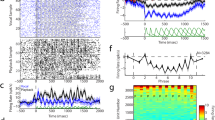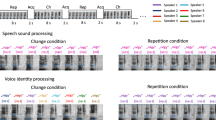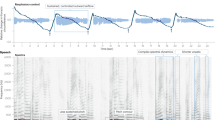Abstract
Vocal communication involves both speaking and hearing, often taking place concurrently. Vocal production, including human speech and animal vocalization, poses a number of unique challenges for the auditory system. It is important for the auditory system to monitor external sounds continuously from the acoustic environment during speaking despite the potential for sensory masking by self-generated sounds1. It is also essential for the auditory system to monitor feedback of one’s own voice. This self-monitoring may play a part in distinguishing between self-generated or externally generated2,3auditory inputs and in detecting errors in our vocal production4. Previous work in humans5,6,7,8,9,10 and other animals11,12,13 has demonstrated that the auditory cortex is largely suppressed during speaking or vocalizing. Despite the importance of self-monitoring, the underlying neural mechanisms in the mammalian brain, in particular the role of vocalization-induced suppression, remain virtually unknown. Here we show that neurons in the auditory cortex of marmoset monkeys (Callithrix jacchus) are sensitive to auditory feedback during vocal production, and that changes in the feedback alter the coding properties of these neurons. Furthermore, we found that the previously described cortical suppression during vocalization actually increased the sensitivity of these neurons to vocal feedback. This heightened sensitivity to vocal feedback suggests that these neurons may have an important role in auditory self-monitoring.
This is a preview of subscription content, access via your institution
Access options
Subscribe to this journal
Receive 51 print issues and online access
$199.00 per year
only $3.90 per issue
Buy this article
- Purchase on Springer Link
- Instant access to full article PDF
Prices may be subject to local taxes which are calculated during checkout




Similar content being viewed by others
References
von Békésy, G. The structure of the middle ear and the hearing of one's own voice by bone conduction. J. Accoust. Soc. Am. 21, 217–232 (1949)
Johns, L. C. et al. Verbal self-monitoring and auditory verbal hallucinations in patients with schizophrenia. Psychol. Med. 31, 705–715 (2001)
Frith, C. D. The Cognitive Neuropsychology of Schizophrenia (Earlbaum Associates, Hillsdale, New Jersey, 1992)
Levelt, W. J. Monitoring and self-repair in speech. Cognition 14, 41–104 (1983)
Houde, J. F., Nagarajan, S. S., Sekihara, K. & Merzenich, M. M. Modulation of the auditory cortex during speech: an MEG study. J. Cogn. Neurosci. 14, 1125–1138 (2002)
Paus, T., Perry, D. W., Zatorre, R. J., Worsley, K. J. & Evans, A. C. Modulation of cerebral blood flow in the human auditory cortex during speech: role of motor-to-sensory discharges. Eur. J. Neurosci. 8, 2236–2246 (1996)
Curio, G., Neuloh, G., Numminen, J., Jousmaki, V. & Hari, R. Speaking modifies voice-evoked activity in the human auditory cortex. Hum. Brain Mapp. 9, 183–191 (2000)
Ford, J. M. et al. Neurophysiological evidence of corollary discharge dysfunction in schizophrenia. Am. J. Psychiatry 158, 2069–2071 (2001)
Crone, N. E. et al. Electrocorticographic gamma activity during word production in spoken and sign language. Neurology 57, 2045–2053 (2001)
Creutzfeldt, O., Ojemann, G. & Lettich, E. Neuronal activity in the human lateral temporal lobe. II. Responses to the subjects own voice. Exp. Brain Res. 77, 476–489 (1989)
Müller-Preuss, P. & Ploog, D. Inhibition of auditory cortical neurons during phonation. Brain Res. 215, 61–76 (1981)
Eliades, S. J. & Wang, X. Sensory-motor interaction in the primate auditory cortex during self-initiated vocalizations. J. Neurophysiol. 89, 2194–2207 (2003)
Eliades, S. J. & Wang, X. Dynamics of auditory-vocal interaction in monkey auditory cortex. Cereb. Cortex 15, 1510–1523 (2005)
Suga, N. & Shimozawa, T. Site of neural attenuation of responses to self-vocalized sounds in echolocating bats. Science 183, 1211–1213 (1974)
Poulet, J. F. & Hedwig, B. A corollary discharge maintains auditory sensitivity during sound production. Nature 418, 872–876 (2002)
Heinks-Maldonado, T. H., Mathalon, D. H., Gray, M. & Ford, J. M. Fine-tuning of auditory cortex during speech production. Psychophysiology 42, 180–190 (2005)
Hashimoto, Y. & Sakai, K. L. Brain activations during conscious self-monitoring of speech production with delayed auditory feedback: an fMRI study. Hum. Brain Mapp. 20, 22–28 (2003)
Fu, C. H. et al. An fMRI study of verbal self-monitoring: neural correlates of auditory verbal feedback. Cereb. Cortex 16, 969–977 (2006)
Sperry, R. W. Neural basis of the spontaneous optokinetic responses produced by visual inversion. J. Comp. Physiol. Psychol. 43, 482–489 (1950)
Wolpert, D. M., Ghahramani, Z. & Jordan, M. I. An internal model for sensorimotor integration. Science 269, 1880–1882 (1995)
Duhamel, J. R., Colby, C. L. & Goldberg, M. E. The updating of the representation of visual space in parietal cortex by intended eye movements. Science 255, 90–92 (1992)
Miller, C. T. & Wang, X. Sensory-motor interactions modulate a primate vocal behavior: antiphonal calling in common marmosets. J. Comp. Physiol. A 192, 27–38 (2006)
Snowdon, C. T. & Elowson, A. M. Pygmy marmosets modify call structure when paired. Ethology 105, 893–908 (1999)
Lane, H. & Tranel, B. The Lombard sign and the role of hearing in speech. J. Speech Hear. Res. 14, 677–709 (1971)
Houde, J. F. & Jordan, M. I. Sensorimotor adaptation in speech production. Science 279, 1213–1216 (1998)
Burnett, T. A., Freedland, M. B., Larson, C. R. & Hain, T. C. Voice F0 responses to manipulations in pitch feedback. J. Acoust. Soc. Am. 103, 3153–3161 (1998)
Brumm, H., Voss, K., Kollmer, I. & Todt, D. Acoustic communication in noise: regulation of call characteristics in a New World monkey. J. Exp. Biol. 207, 443–448 (2004)
Timmons, B. A. & Boudreau, J. P. Auditory feedback as a major factor in stuttering. J. Speech Hear. Disord. 37, 476–484 (1972)
Hoffman, K. L. & McNaughton, B. L. Coordinated reactivation of distributed memory traces in primate neocortex. Science 297, 2070–2073 (2002)
Lu, T., Liang, L. & Wang, X. Neural representations of temporally asymmetric stimuli in the auditory cortex of awake primates. J. Neurophysiol. 85, 2364–2380 (2001)
Acknowledgements
We thank B. McNaughton for sharing implanted multi-electrode recording methods. We acknowledge A. Pistorio for assistance in animal care, M. Melamed for assistance in data collection and C. Miller for his comments on this manuscript. This work was supported by NIH grants to X.W.
Author Contributions S.J.E. and X.W. designed the experiments and co-wrote the paper. S.J.E. carried out the experimental recordings and data analysis.
Author information
Authors and Affiliations
Corresponding authors
Supplementary information
Supplementary information
The file contains Supplementary Methods, Supplementary Discussion, additional references and Supplementary Figures S1-S10 with Legends. (PDF 6914 kb)
Rights and permissions
About this article
Cite this article
Eliades, S., Wang, X. Neural substrates of vocalization feedback monitoring in primate auditory cortex. Nature 453, 1102–1106 (2008). https://doi.org/10.1038/nature06910
Received:
Accepted:
Published:
Issue Date:
DOI: https://doi.org/10.1038/nature06910
This article is cited by
-
Temporal scaling of motor cortical dynamics reveals hierarchical control of vocal production
Nature Neuroscience (2024)
-
Altered corollary discharge signaling in the auditory cortex of a mouse model of schizophrenia predisposition
Nature Communications (2023)
-
Secondary auditory cortex mediates a sensorimotor mechanism for action timing
Nature Neuroscience (2022)
-
Echolocation-related reversal of information flow in a cortical vocalization network
Nature Communications (2022)
-
A quantitative model reveals a frequency ordering of prediction and prediction-error signals in the human brain
Communications Biology (2022)
Comments
By submitting a comment you agree to abide by our Terms and Community Guidelines. If you find something abusive or that does not comply with our terms or guidelines please flag it as inappropriate.



